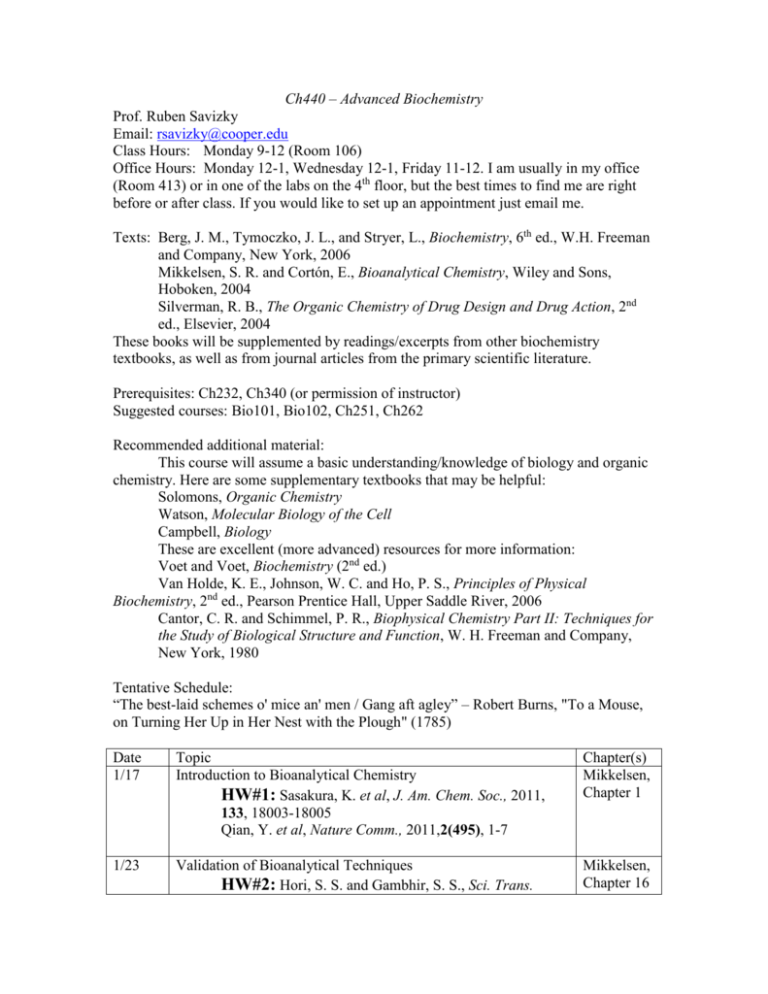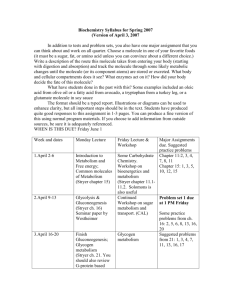
Ch440 – Advanced Biochemistry
Prof. Ruben Savizky
Email: rsavizky@cooper.edu
Class Hours: Monday 9-12 (Room 106)
Office Hours: Monday 12-1, Wednesday 12-1, Friday 11-12. I am usually in my office
(Room 413) or in one of the labs on the 4th floor, but the best times to find me are right
before or after class. If you would like to set up an appointment just email me.
Texts: Berg, J. M., Tymoczko, J. L., and Stryer, L., Biochemistry, 6th ed., W.H. Freeman
and Company, New York, 2006
Mikkelsen, S. R. and Cortón, E., Bioanalytical Chemistry, Wiley and Sons,
Hoboken, 2004
Silverman, R. B., The Organic Chemistry of Drug Design and Drug Action, 2nd
ed., Elsevier, 2004
These books will be supplemented by readings/excerpts from other biochemistry
textbooks, as well as from journal articles from the primary scientific literature.
Prerequisites: Ch232, Ch340 (or permission of instructor)
Suggested courses: Bio101, Bio102, Ch251, Ch262
Recommended additional material:
This course will assume a basic understanding/knowledge of biology and organic
chemistry. Here are some supplementary textbooks that may be helpful:
Solomons, Organic Chemistry
Watson, Molecular Biology of the Cell
Campbell, Biology
These are excellent (more advanced) resources for more information:
Voet and Voet, Biochemistry (2nd ed.)
Van Holde, K. E., Johnson, W. C. and Ho, P. S., Principles of Physical
Biochemistry, 2nd ed., Pearson Prentice Hall, Upper Saddle River, 2006
Cantor, C. R. and Schimmel, P. R., Biophysical Chemistry Part II: Techniques for
the Study of Biological Structure and Function, W. H. Freeman and Company,
New York, 1980
Tentative Schedule:
“The best-laid schemes o' mice an' men / Gang aft agley” – Robert Burns, "To a Mouse,
on Turning Her Up in Her Nest with the Plough" (1785)
Date
1/17
Topic
Introduction to Bioanalytical Chemistry
HW#1: Sasakura, K. et al, J. Am. Chem. Soc., 2011,
133, 18003-18005
Qian, Y. et al, Nature Comm., 2011,2(495), 1-7
Chapter(s)
Mikkelsen,
Chapter 1
1/23
Validation of Bioanalytical Techniques
HW#2: Hori, S. S. and Gambhir, S. S., Sci. Trans.
Mikkelsen,
Chapter 16
1/30
Med., 2011, 3(109), 1-9
Palacios, M. A. et al, Proc. Nat. Acad. Sci. USA,
2011,108(40), 16510-16514
Antibodies and Immunoassays
HW#3: Kelkar, S. S. and Reineke, T. M., Bioconjugate
Chem., 2011, 22, 1879-1903
Stryer,
Chapter 3
and
Mikkelsen,
Chapter 5
Stryer,
Chapter 8
and
Mikkelsen,
Chapter 3
Stryer,
Chapters 8
and 9 and
Silverman,
Chapter 5
2/5
Enzymes
2/12
Enzyme Inhibition and Inactivation
HW#4: Nomura, D. K. et al, Science, 2011, 334, 809813
Duggan, K. C. et al, Nature Chem. Biol., 2011,7, 803809
2/26
Membrane Channels and Pumps
HW#5: Vedula, L. S. et al, J. Biol Chem., 2011,
284(36), 24176-24184
Nury, H. et al, Nature, 2011, 469, 428-433
Stryer,
Chapter 13
3/5
Signal Transduction Pathways
HW#6: Chung, K. Y. et al, Nature, 2011, 477, 611-617
Westfield, G. W. et al, Proc. Nat. Acad. Sci USA, 2011,
108(38), 16086-16091
Stryer,
Chapter14
3/19
3/26
Student Presentations – Bioanalytical Techniques
4/2
4/9
4/16
Metabolism overview
Stryer,
Chapter 15
Drug Discovery, Design and Development
Stryer,
HW#7: Visnyei. et al, Mol. Cancer Ther., 2011, 10(10), Chapter 35
and
1818-1828
Silverman,
Xie, J. et al, J. Am. Chem. Soc., 2011,133, 13946-13949
Chapter 2
Structure-Activity Relationships
Silverman,
Chapter 2
HW#8: Perales, J. B. et al, Bioorg. Med. Chem. Lett.,
2011, 21, 2816-2819
Yuan, J. et al, Science, 2011,333, 724-729
DNA-Interactive Agents
HW#9: Thomas, J. R. and Hergenrother, P. J., Chem
Rev., 2008, 108(4), 1171-1224
Stryer,
Chapters 4
and 28 and
4/23
Drug Metabolism
4/30
Prodrugs and Drug Delivery Systems
HW#10: Namanja, H. A. et al, J. Am. Chem. Soc.,
2011, ASAP, A-E
Walsh. et al, ACS Nano., 2011,5(7), 5427-5432
5/4
Student presentations – Original Grant Proposal
Silverman,
Chapter 6
Silverman,
Chapter 7
Silverman,
Chapter 8
Course layout:
The class will consist of lectures on these various topics. There will be ten homework
assignments and two projects.
Homework:
Homework will consist of journal summaries. You will have a week to complete the
assignment. Generally, it will be collected and graded. The journal article summaries will
attempt to show you applications of the concepts. For the critiques, you will be given an
article (or two) from the biochemical literature and will be given one week to read
it(them). You will also be expected to write a short (2-5 page) summary, which should
include a brief synopsis of the paper(s), the significance, as well as the pros and cons of
the experiment/technique/approach. We will then discuss the paper(s) in class the
following week.
Project 1: Description of a bioanalytical technique
In lieu of a midterm exam you will be asked to research and describe a bioanalytical
technique. You may choose from the following suggestions: fluorescence polarization,
FRET, size exclusion chromatography, hydrodynamic chromatography, dynamic light
scattering, biomarkers, catalytic antibodies, SELEX, yeast two-hybrid systems, capillary
electrophoresis, isoelectric focusing, MALDI TOF MS, FT-ICR MS, VCD, TIRF
microscopy, FISH, ITC, DSC, photoacoustic calorimetry, surface plasmon resonance,
NOESY, TROSY, MAD X-ray diffraction, CARS. You can also choose something not
on the list, pending my approval. Each student should present a different bioanalytical
technique. I will pass around a sheet for each student to list his/her topic in class. For this
project you will be asked to write a report as well as give an oral presentation. Your
report should contain the basic elements of a technical paper: abstract, introduction,
procedure, results, conclusion, and references. You will also be expected to do an oral
presentation (approximately 10-15 minutes) of your work.
Project 2: Grant proposal
In lieu of a final exam you will be asked to write a final paper, in the form of an original
research proposal. You may choose something related to any of the topics that will be
covered, or something that we have not talked about. In either case you will need to get
my approval. Of primary importance is that your idea be unique (though it certainly can
be based on the work of others). Your proposal should contain the basic elements of a
technical paper: abstract, introduction, procedure, results, conclusion, and references.
You will also be expected to do an oral presentation (approximately 10-15 minutes) of
your work.
Your proposal should abide by the National Science Foundation (NSF) Grant Proposal
Guidelines (GPG), which I will provide as a .pdf file. Please be sure to read this
thoroughly. As an example, you may consider your proposal to be for a Cellular
Processes solicitation under the Molecular and Cellular Biosciences (MCB) division of
the Directorate for Biological Sciences (BIO). The synopsis of this solicitation is copied
below:
(http://nsf.gov/funding/pgm_summ.jsp?pims_id=503612&org=MCB&from=home)
The Cellular Processes Cluster encourages the use of innovative approaches and
technologies that resolve long-standing questions in cell biology. The cluster seeks to
support imaginative projects that integrate research on processes at the supramolecular
and cellular scales. The cluster recognizes the need for rigorous, quantitative approaches
for cell biology and welcomes multidisciplinary research that includes physical,
mathematical, and computational approaches. Areas of particular interest include livecell imaging, single-particle analysis of macromolecular assemblies, architectural
organization and dynamics of structures over broad dimensional scales. This cluster
entertains proposals in the following general areas of cell biology:
Membrane organization and function
Organelle biogenesis, maintenance, and trafficking
Cytoskeletal dynamics, cell division and motility
Remember that plagiarism is a serious offense. Please make sure you make
appropriate citations and reference the works you use. Plagiarism includes copying
words AND ideas/concepts. For example if someone else comes up with a hypothesis
or explanation you have to say something like "Smith proposes ...". You cannot
imply that it was your hypothesis or explanation. If I feel you have plagiarized you
will receive a grade of 0 for the assignment.
Grades: Your grade will be determined as follows:
Homework:
40%
Project 1:
30% (Report 20%, Oral Presentation 10%)
Project 2:
30% (Report 20%, Oral Presentation 10%)










